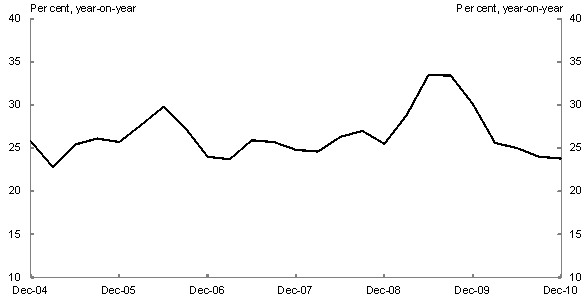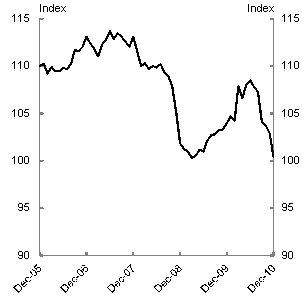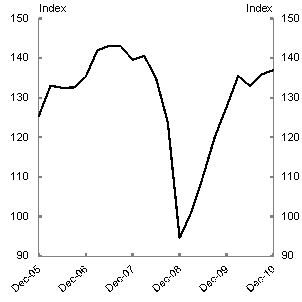The stimulus package played a key role in supporting the Chinese economy in the wake of the global financial crisis. As a result of the stimulus, China was one of the first countries to emerge from the crisis, with China's GDP growth starting to recover during the second and the third quarters of 2009.
The stimulus created a surge in fixed asset investment (see Chart 5). The growth rate of investment in fixed assets accelerated rapidly, exceeding 30 per cent (through the year) in the latter half of 2009. The speed with which the Chinese Government was able to stimulate investment would have been helped by the existence of a large pipeline of viable projects. Streamlined decision-making and planning processes in China, and government actions to ensure financing was readily available, also helped the process of getting investment into the economy quickly.
Chart 5: China's fixed asset investment

Source: CEIC Data 1990-2011.
Consumer and business confidence were boosted by the fiscal stimulus. Consumer confidence fell by 7 per cent in the six months following the onset of the financial crisis. From March 2009, consumer confidence slowly but steadily rebounded. Business confidence, measured using the entrepreneur confidence index, fell by around 24 per cent between the third quarter and fourth quarters of 20081. However, by the third quarter of 2009, business confidence had returned to be above the pre-crisis level (see Chart 6).
Chart 6: China's consumer and business confidence
Consumer confidence

Business confidence

Source: CEIC Data 1990-2011.
Empirical studies suggest that China's stimulus package added around 2-3 per cent to the level of GDP in both 2009 and 2010 (Table 2). This expansion was the direct effect of the package; expansion of credit to the private sector would have added further to GDP.
Countries that are key exporters of commodity and capital goods to China, such as Japan, South Korea, Australia, and Brazil, were in a good position to benefit from the boost to China's domestic demand as a result of the package, although the effects were likely small. Based on an estimated import leakage from the package of about 30 per cent, or US$94 billion, the effect on the exports of Japan and South Korea would have been 2-3 per cent of their exports and 1-2 per cent for Australia and Brazil. Dynamic computable general equilibrium (DCGE) modelling work by Cova et. al. (2010) also suggests that flow-on effects to the rest of the world were modest.
Table 2: Empirical analyses of the effects of China's stimulus
A few studies have attempted to quantify the impact of China's fiscal stimulus. He et. al. (2009) analysed the effects of China's stimulus package on output and employment, based on two independent models, an input-output (I-O) model and the Global Integrated Monetary and Fiscal (GIMF) model calibrated to China.
The I-O analysis considers the structure of the Chinese economy and includes 17 production sectors. The model suggests that the announced fiscal spending of RMB 2 trillion in 2009 would lead to a direct increase in output of RMB 1.7 trillion, implying a fiscal multiplier of around 0.84 in the short run, and could potentially generate 18-20 million new jobs in non-farming sectors. However, the I-O approach has its limitations since it is a static analysis and does not take into account the second-round effects on components of final demand.
The GIMF is a dynamic, stochastic general equilibrium multi-country model with overlapping generations, which integrates domestic supply, demand, trade, and international asset markets in a single theoretical structure, thereby allowing transmission mechanisms to be fully articulated. The model in the study consists of eight regions. Simulations using the GIMF model showed that the fiscal multiplier on output ranges between 0.80 and 0.84 in the short run, and it is about 1.1 in the medium run as government fiscal spending leads to higher household consumption and corporate investment, which will take time to fully materialise.
Diao et. al. (2010) use a DCGE model to determine the impact of the recent global recession and the Chinese stimulus package on China's economic growth. The study finds that China's economy could have been more negatively affected by the global recession than actually occurred in late 2008 and early 2009 without the introduction of the stimulus package. The stimulus package not only ensured China avoided a long-term decline in economic growth, it also provided China with a different engine for future growth through an enhanced domestic market. According to this model, the cumulative gains of the stimulus package measured by the increase in China's GDP will be about RMB 76 trillion over 2009-2015. The authors noted that this number is about three times China's 2007 GDP but it may still underestimate the expected long-run impact of public investment on growth through further stimulation of structural change and productivity increase, which is not considered in the analysis.
Another study that used a DCGE model to evaluate the macroeconomic impact of the fiscal stimulus is Cova et. al. (2010). The model is calibrated to China, the USA, Japan, the euro area, and the rest of the world. The analysis indicated that, absent fiscal stimulus, China's GDP would be 2.6 percentage points and 0.6 percentage points lower in 2009 and 2010, respectively. Compared to the baseline scenario, the fiscal stimulus package would induce an increase in China's imports equal to roughly 3.0 per cent and exports would decline by slightly more than 1.0 per cent on average over 2009 and 2010. The increase in China's imports is driven by higher aggregate demand. Exports from Japan and the rest of the world would benefit from the stimulus to a lesser extent than those of the USA and the euro area, given that China's trade composition is mainly biased towards the former two regions. The increase in exports for China's trading partners equals, on average, 0.6 per cent for Japan and the rest of the world, while it only amounts to 0.15 per cent for the USA and the euro area. Th
e overall impact of China's stimulus on GDP in the rest of the world is limited.